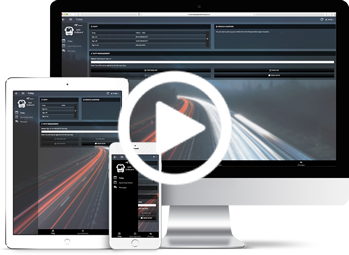Passenger Information Displays – for Every Stage of the Journey
Find out the history of Passenger Information Displays, and why they are needed from the beginning to the end of every journey to make the passenger experience better. Part of 2 of a 3-part series on passenger information
Introduction
You are running late. As you run to the station entrance, you see a passenger information sign that tells you the train is on time. You race down the stairs, cross under the line, and back up the stairs as you hear the train pulling in. Short of breath, you look for the nearest carriage door, and suddenly realise you are on the wrong platform. It is too late to get across to the right platform, and you miss the train. The information at the station entrance might have been correct, but it did not meet your needs.
This is a case of poor information. You may think that poor information may be better than no information. But in some instances, it is worse than no information, as it results in bad customer decisions, bad outcomes, and a poor passenger experience.
Fortunately, public transport passenger information technology is trying to address this issue.
The History of Passenger Information
In its early years, simple timetables were printed and posted on the wall. This approach was improved upon with standalone systems that provided basic audio and visual messages about services. But these messages were not integrated at the stop or on-board systems. Call centres provided relevant timetable information, and disruption notifications and real-time information was first seen on phones in the 1990s via SMS. By 2000, technology had evolved into early real-time passenger information (RTPI) displays that showed arrival times and gave some planned service information.
Printed information matured further to incorporate QR codes and Near Field Communication (NFC), and Wi-Fi and next stop announcements all became common on buses, trams, trains, and ferries. In the 2010’s, smartphones delivered real-time information together with trip planning to people on the move. RTPI signs came of age with advanced prediction algorithms, graphical route maps, and other visual formats.
This brings us to today. ‘What journey should I take to get there quickly, efficiently and cost-effectively?’ This question occurs many times across the city, and in today’s connected world, there is an expectation that this information is available instantaneously and is accurate.
Passenger Information Types
The passenger information journey has been described by Transport for NSW as per Figure 1:
Figure 1 Overview of the customer journey
This graphic identifies passenger information needs at every stage of the journey. For instance, our passenger arriving at the train station needs to know the train departure time and platform. It may also be necessary to verify that the service stops at the destination station, particularly if it is not a mainstream station.
Passengers at the concourse/boarding stage want confirmation that their service is arriving, with accessibility details, load factors and route details. Once onboard, they seek information on journey progress and when to get off, as well as the status of connecting services at their stop – so that they can continue their journey stress-free.

To deliver this varied need for information, a modern customer information system delivers a combination of general service information, alerts of imminent hazards, and warns passengers of an emergency. Some systems also contain information on special events and general network disruption.
General service information relates to a journey, interchange, or destination, and includes planned and unplanned disruptions. Typically, at the stop, this information includes the route, destination (and perhaps a stopping pattern), the platform, bay, or stop side, as well as the predicted arrival or departure time. It may also include information about the stop itself such as ‘stop closed until 3 July due to road widening’, or wayfinding information – ‘the nearest stop is 100 metres back up Smith Street.’
If the stop is shared by multiple routes or meets another transport mode, information on planned connections is useful. Passengers alighting from one mode can immediately see where and when they need to be to continue their journey. This connecting journey information is also valuable when travelling, as it supplies passengers with information on what stop to alight from to make their connecting service.
Alerts of imminent hazards normally relate to onboard messages but can also apply to the stop. These can be largely automated, be delivered by recorded voice announcements as well as on screens, and include such favourites as ‘mind the gap’ or ‘door closing, please stand clear.’
Other announcements may be more informative, for example, alight here information for local attractions or sports stadiums that enable passengers to disembark at the most appropriate gate or entrance.
For most journeys, the general service information is sufficient for passengers to understand what is happening to services that affect them. However, when there is a large service disruption, additional information is needed. Passenger displays can advise passengers of the reason for delays, if services are cancelled, and what options are available to them. This might include messages such as ‘all services delayed due to a car accident inbound on East Street’, or ‘train services stopped – please use buses to transfer to Alexander Station’.
What do you need to know?
Passenger information devices show different information based on what you need to know at that point in the journey. When approaching a stop, you need to know which platform or bay to go to, based on that route. You don’t need information on every service at every stop. At the stop, you need to know the services that use that stop, their stopping pattern/destination, and when they are arriving. On board, you need to know when you will arrive at the stops along the route, and what connecting services or other transport options are available at those stops.
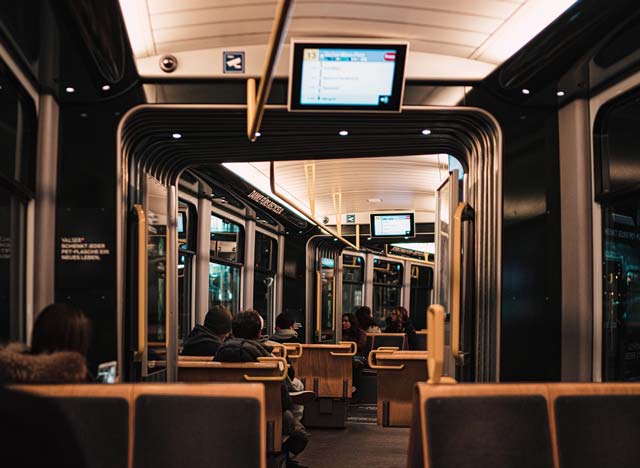
Information needs also change based on the mode of transport, with multimodal information being particularly valuable between trips e.g., when getting off the bus and seeking the tram service information. Even better, is showing this multimodal information onboard, so passengers can potentially decide to stay on the bus rather than waiting for the tram.
Furthermore, even at the same point in the journey, passengers’ needs are not all the same. Blind people require audio messages, and if they are not provided automatically, then they require a way to activate them. If you are in a wheelchair, you need to be able to see the information clearly, so viewing angles are important. You may also require reassurance that the vehicle has been requested to stop and that the driver is aware there is a wheelchair passenger wanting to alight.
Passenger Information Displays (PIDs) Technology
So far, we have discussed the need for information.

This is highly dependent on the technology selected. At Trapeze, we recognise there is no one right solution, and that an effective passenger information system will consist of different technologies selected for their particular function, as well as a range of physical, financial, and political considerations.
The four main PIDs technologies are:
- LED. A stalwart of earlier RTPI systems, LED displays provide a row-by-row display of information. The information was typically in a single colour (amber, red, green, and more recently, white). Each character was made up of a fixed pattern of LEDs, and lines potentially limited to 24 characters. Although quite limited in their capability, these signs were great at the time, and still have a niche, and with increased resolution they continue to be used outdoors where other technologies are unsuitable.
- LCDs provide a colour, graphical representation of information. These displays need to be large (over 40 inches) and historically, this made them expensive. Another drawback was that unless they were of high brightness, they could not be seen in full sunlight. However, this is no longer the case, and large, high brightness displays are available at reasonable prices. LCD displays are particularly well suited to indoor locations, providing platform signs as well as general interchange information.
- E-ink is a relatively new technology that provides a graphical image in 16 shades of grey. These displays have extremely wide viewing angles, can be clearly seen in direct sunlight, and have a very low power consumption – making them ideal for solar power.
- Mobile channels. Every city has one or many public transport apps to plan and receive updates on your services on the go. In some apps, you can even buy a ticket and book for other modes (e.g., bike share service). However, they do not strictly fall under the banner of a passenger information display device, and so will not be further discussed here.
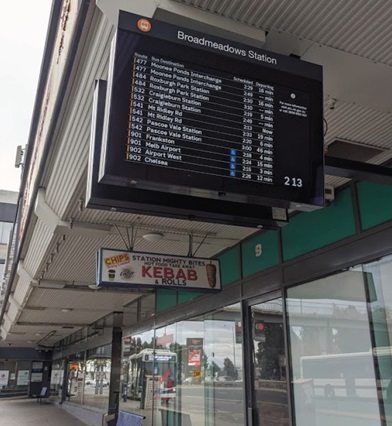
Factors that should be considered when selecting passenger information technology include:
- Viewing angles. Normally, the wider the better, as this allows more people to see the information from multiple positions.
- Sunlight visibility. For signs in an underground station, this may not be an issue, but at a bus or tram stop in the open, it is important that passengers can read the sign in all lighting conditions, from fully dark to bright sunlight. If you are using LED or LCD technologies, then this requires bright displays. If e-ink, then you will need a secondary light source.
- Character resolution. On a platform, the text on a display should be sufficiently large that the majority of passengers on the platform can comfortably read the display.
- Colour selection. As 4.5% of all passengers are colour blind, careful selection of display colours on an LCD is needed. This choice is not as critical on LED or e-ink technologies, as these are typically mono colour.
- Power supply. Securing power to some displays is a challenge and can cost more than the sign. Normally, this is not a problem in new constructions such as a bus station or when a tram stop is upgraded. But for some locations, the power supply is nowhere near the stop, and solar power may be the best option. It is always important to consider both the cost of connection and the ongoing power consumption in your technology decision.
- Housing design. This is needed for:
- Environmental protection. Waterproofing (IP rating), vibration and shock (IK rating) are important to prevent failures. Stop signs are subject to harsh weather, rain, and vandalism. On board displays are subject to ongoing shock and vibration, as well as electromagnetic interference from overhead traction supply systems.
- Temperature protection. The system needs to operate during the summer when it can be up to 70 degrees Celsius inside the cabinet, through to sub-zero temperatures in winter.
- Disability legislation compliance is now widely accepted. The height of the sign and the audio push button are both very important for people in wheelchairs, while the force needed to activate the button is important for the elderly. The use of high contrast text, text to speech audio, tactile text, and Braille are essential for the sight impaired.
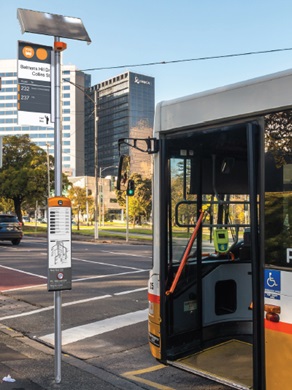
- Upgradability. There is an ongoing push for faster wireless communications, which have evolved from 2G to 3G to 4G and now to 5G. Future PIDs will leverage these increased bandwidth capabilities, with Trapeze currently considering camera-fitted displays for counting passengers at stops and providing an interactive stop experience. Future innovations may include facial recognition with personalised information.

Conclusion
Having the right information in the right place can really help passengers make use of the public transport network. This information will differ as the passenger moves through their journey. Whilst there are a range of technologies to help deliver general service and disruption information to passengers, the selection of these technologies requires the consideration of many factors.
Good passenger information comes from good quality vehicle tracking, advanced prediction algorithms and a powerful sign management system that can tie these information sources together – delivering the right message to all passengers. When you run for the train, you get to the right platform on time, and when you’re onboard knowing that your stop is 10 minutes away and your connecting service will be waiting, you are relaxed and in control and your overall public transport travel experience is enhanced.
For you, the passenger information system’s job is done. For others, the journey is only just beginning.
To find out how Intelligent Transport Systems (ITS) technology can help you deliver your customers the service they want, contact us today, and visit our ITS hub.
This article is Part 2 of a series on passenger information. See also:
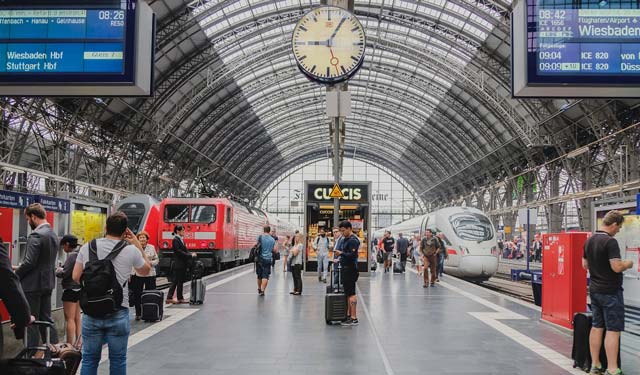
Here to help
Contact us and speak with one of our specialists:
+44 (0) 808 281 1039
More Info
About Us | Careers | Contact Us | Legal | Privacy
(c) 1999 – 2021 Trapeze Software ULC. All rights reserved
Trapeze Group respects your privacy


